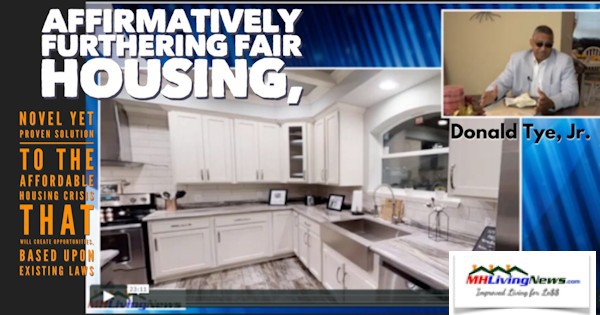
In a recent report, MHProNews spotlighted the position that the National Association of Manufactured Home Community Owners has taken in engaging on the pending Trump Administration Disparate Impact Rule at HUD. ICYMI, see that report from the linked text-image box below.
That raised the question among some readers, what has HUD specifically said about this topic? HUD and other federal agencies churn out press releases routinely, and MHProNews picks and choses among them as to what may be of greater interest and impact to the industry. The question was a fair one, so we’ll catch up on disparate impact with the following.
Following the definition graphic is HUD’s most recent media release on the topic.

HUD PROPOSES REVISED ‘DISPARATE IMPACT’ RULE
New proposed disparate impact rule more appropriately reflects 2015 Supreme Court ruling
WASHINGTON – The U.S. Department of Housing and Urban Development (HUD) today published a proposed rule to amend the HUD interpretation of the Fair Housing Act’s disparate impact standard. The proposed rule as amended would provide more appropriate guidance on what constitutes unlawful disparate impact to better reflect the Supreme Court’s 2015 ruling in Texas Department of Housing and Community Affairs v. Inclusive Communities Project, Inc. Read HUD’s proposed rule.
“There is a lack of affordable housing in America today,” said HUD Secretary Ben Carson. “This proposed rule is intended to increase legal clarity and promote the production and availability of housing in all areas while making sure every person is treated fairly under the law. As we have shown time and again, we will challenge any practice that discriminates against people that the law protects. At the end of the day, this rule not only increases Americans’ access to fair and affordable housing, but also permits businesses and local governments to make valid policy choices.”
The HUD proposed disparate impact rule provides a framework for establishing legal liability for facially neutral practices that have unintended discriminatory effects on classes of persons protected under the Fair Housing Act. The rule has no impact on determinations of intentional discrimination. In its 2015 decision, the Supreme Court upheld the use of a ‘disparate impact’ theory to establish liability under the Fair Housing Act for business policies and local ordinances even if the policy or ordinance is neutral – in intent and application – if it disproportionately affects a protected class without a legally sufficient justification.
###

For more information, see the related reports following the notices and byline.

That’s take two today on your home for the #1 runaway most-read “Industry News, Tips, and Views Pros Can Use” © where “We Provide, You Decide.” © ## (News, analysis, and commentary.)

Soheyla is a managing member of LifeStyle Factory Homes, LLC, the parent company to MHProNews, and MHLivingNews.com. Connect with us on LinkedIn here and
Related Reports:
Click the image/text box below to access relevant, related information.

Nadeen Green says Disparate Impact case could rock MH & MHC owners, managers world
Federal Manufactured Housing Program Review Comments Due Next Week, 2.26.2018



























